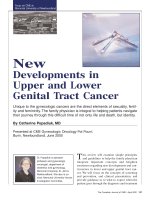New Developments in Upper and Lower Genital Tract Cancer potx
Bạn đang xem bản rút gọn của tài liệu. Xem và tải ngay bản đầy đủ của tài liệu tại đây (122.03 KB, 12 trang )
The Canadian Journal of CME / April 2001 137
T
his review will examine simple principles
and guidelines to help the family physician
integrate important concepts and heighten
awareness regarding new developments and con-
troversies in lower and upper genital tract can-
cer. We will focus on the concepts of screening
and prevention, and clinical presentation, and
provide guidance as to what to expect when the
patient goes through the diagnosis and treatment
New
Developments in
Upper and Lower
Genital Tract Cancer
Unique to the gynecologic cancers are the direct elements of sexuality, fertil-
ity and femininity. The family physician is integral to helping patients navigate
their journey through this difficult time of not only life and death, but identity.
By Catherine Popadiuk, MD
Presented at CME Gynecologic Oncology Pot Pourri,
Burin, Newfoundland, June 2000
Focus on CME at
Memorial University of Newfoundland
Dr. Popadiuk is assistant
professor and gynecologic
oncologist, department of
obstetrics and gynecology,
Memorial University, St. John’s
Newfoundland. She also is co-
chair, Memorial University Human
Investigation Committee.
of gynecologic malignancy.
Breast cancer, as the most prevalent cancer—
affecting one in nine women—is a good point of
comparison. In contrast, the most common gyne-
cologic malignancies, such as endometrial, ovari-
an and cervical cancer, affect one in 37, one in 70,
and one in 100 women, respectively.
1
The remain-
ing gynecologic cancers—vulva, vagina and fal-
lopian tube—occur very infrequently (Table 1).
Given the small number of women affected
with these cancers, the literature addressing gyne-
cologic oncology does not have many randomized
controlled trials with the numbers required to gen-
erate statistically significant results. Much of what
gynecologic oncology management is based upon
are long-standing precepts and center-dependent
preferences for management.
Cervical Cancer
Cervical cancer is the eleventh most frequently diag-
nosed cancer among Canadian women and the sec-
ond most common form of cancer in women world-
wide. In 2000, 1,450 women in Canada developed it
and 430 women died of it. These figures are thought
to be underestimated, as death certificates often mis-
code cervical cancer as being uterine cancer.
2
Aclas-
sic case was Evita Peron, wife of the president of
Argentina, who it was thought died of uterine cancer
at age 33. In reality, she died from cervical cancer
and had the classic risk factors (Table 2).
These include early age at first intercourse, a high
number of sexual partners and exposure to high-risk
males (men who have had multiple partners,
arguably are uncircumsized or who are from certain
geographic locations, such as Africa or Latin
America).
3
Prior to Evita’s death, Juan Peron had
watched his first wife succumb to the same disease.
4
The risk factors increase one’s chances of being
exposed to the high-risk human papillomavirus
(HPV) subtypes 16 and 18, arguably associated with
all squamous cell and adenocarcinoma of the cervix.
Other risk factors include human immunodeficiency
virus (HIV) infection. The most important risk fac-
tor for cervical cancer is not having had a
Papanicolaou’s (Pap) smear. With the advent of Pap
smear screening, mortality has decreased 90%.
5
In Canada, mortality and incidence from cer-
vical cancer is highest in the elderly, with a sec-
Gynecologic Cancer
138 The Canadian Journal of CME / April 2001
Table 1
Canadian Cancer Statistics
Type Prevalence Deaths
Breast 19,200 5,500
Lung 8,400 7,000
Colorectal 7,900 3,000
Uterus 3,500 670
Ovary 2,500 1,500
Pancreas 1,600 1,500
Cervix 1,450 430
Table 2
Cervical Cancer Risk Factors
• Not having a Pap smear
• Early onset of sexual activity
• Multiple sexual partners
• Exposure to high-risk male partners
• Human immunodeficiency virus infection
• Increased age
•Lower socioeconomic status
• Smoking
• Controversial dietary deficiencies—vitamin A
•Oral contraceptive pill
ond peak in the 35- to 40-year-old range in
females. In most cases, the patients did not have
regular annual screening (up to 15% have never
had a Pap smear). The Pap smear detects pre-
cancerous cells affordably and simply, so that
treatment can be instituted to prevent cancer.
The test is not meant to detect cancer cells. The
Canadian task force on the periodic health exam-
ination recommends women should have annual
Pap smears once they are sexually active or at
age 18. If an organized screening program is in
place, with quality control and information sys-
tems, this frequency may be reduced for women
to three normal annual smears every three years
until age 69. Only British Colombia, Nova
Scotia and Prince Edward Island have adopted
these suggestions for an organized central
screening program (to varying extents).
2
Despite these recommendations, women in
Canada are still dying from this preventable dis-
ease. Most provinces rely on opportunistic screen-
ing. Hence, most Pap smears are done frequently
in younger women of childbearing age, and less so
the older age group, where mortality and inci-
dence are greatest (Figure 1).
We must do better. Public education
can help address fears and anxiety about
the test. Although the high-risk HPV is
more likely to be acquired through multi-
ple sex partners, it only takes one sexual
partner to acquire the cancer later in life.
A positive Pap smear does not mean can-
cer. It means abnormal cells have been
found that can be treated, thereby pre-
venting cancer. These are the messages to
get across to our patients.
Case histories. One patient the
author treated for cervical cancer who
did not have a Pap smear said she
thought she was saving the health-care
system money by not being a burden to
have the test. Had she been educated about the
virtues of having a Pap smear done, she would
have come in.
Another tragic case represents the priorities
our patients now maintain. A 38-year-old Gravida
2 Para 2 (G2P2) homemaker presented to the
emergency department with vaginal bleeding and
palpitations. Her hemoglobin was 72 g/l and, fol-
lowing transfusion, she felt better. On history, she
reported vaginal bleeding intermenstrually and
post-coitally for two years. Over the last two
months, the bleeding worsened and was associat-
ed with profuse foul-smelling discharge. The
patient had experienced trouble urinating for the
past year and crampy abdominal pain for the last
month. She had not had a Pap smear for 10 years,
since the birth of her second child. She had been
very busy caring for her children and mother-in-
law, who suffered from Alzheimer’s and lived
with the family. The patient had no time for her-
self until she arrived in the hospital, wearing
incontinence pads because of leaking urine from a
vesicovaginal fistula.
She went on to be staged and was found to have
a necrotic tumor extending into the bladder on
The Canadian Journal of CME / April 2001 139
Figure 1. Incidence of Pap smears.
Gynecologic Cancer
cystoscopy. The tumor was eroding out towards
both pelvic sidewalls on clinical examination, and
in combination with lung metastases that showed
up on chest x-ray, made her Stage 4B. Staging
does not include computed tomography (CT)
scans or the use of expensive high-tech instru-
ments, as the World Health Organization (WHO)
recommends simple testing. The reason for this is
patients in developing countries, where cervical
cancer is the number two cancer, cannot afford
expensive staging techniques.
The patient went on to be treated with high-
dose “palliative” radiation. Since her radiation two
years ago, she has had a good quality of life main-
tained by a regular, increasing dose of morphine
for the pain; oral flagyl to combat the odor from
the necrotic tumor; and the essential support of
family and her primary-care physician.
More recently, the tumor blocked her femoral
veins, causing blood clots and lymphedema of her
lower limbs. She was started on low molecular
weight heparin, which works better in this cancer
situation than warfarin. The anticoagulation
caused profuse bleeding from the central tumor.
This was successfully treated with vaginal packing
and arterial embolization. She then presented with
pleural effusions and renal failure. After much
thoughtful discussion with her family, she pro-
ceeded with percutaneous nephrostomy tube
placement and drainage of the effusion. She was
not ready to die of renal failure at the age of 40.
She is currently stable at home, trying to live to
another birthday. The tumor in her vagina and the
computed axial tomography (CAT) scan per-
formed on her are shown in Figures 2 and 3.
Cervical cancer, except for the earliest of stages
up to 2A, for which radical hysterectomy is
offered (sparing the ovaries in pre-menopausal
women), is treated with radiation therapy. The
most profound development in treatment has been
an improvement in local control and survival with
the addition of chemotherapy, often cisplatin, as a
radiation sensitizer.
6,7
Given once weekly with the
radiation, there are few side effects: no alopecia,
nor the renal and neurotoxicity seen with cisplatin.
Chemotherapy is not used to eradicate possible
metastases throughout the body, but strictly to
“sensitize” the tumor cells to the radiation locally
and regionally within the pelvis. Occasionally,
after a radical hysterectomy, radiation is given to
prevent recurrence if the patient’s features suggest
aggressive tumor behavior. Chemotherapy, in a
Gynecologic Cancer
140 The Canadian Journal of CME / April 2001
Figure 2. A patient’s cervical tumor.
Figure 3. A patient’s CAT scan.
similar adjuvant setting to prevent distant recur-
rence, has not been shown to be effective in previ-
ous trials. Also, it has not been shown in random-
ized controlled trials to be effective in a neo-
adjuvant setting—before definitive treatment with
surgery or radiation, in an attempt to shrink the
tumor and prevent distant metastatic spread.
5
Chemotherapy was not used in the aforemen-
tioned patient. As with most cervical cancer
patients, she suffers and will die from the central
tumor effects. Systemic chemotherapy, a platinum
agent, can be used to attempt to decrease lymph
node involvement or the lung metastases. With
chemotherapy in such a setting, morbidity must be
considered, particularly if the patient is not symp-
tomatic in these areas.
Vulvar and Vaginal Cancer
Abnormalities found in Pap smears and a history
of prior treatment for cervical dysplasia necessi-
tates vigilant follow-up of the entire lower genital
tract, which is predisposed to the same ill effects
by HPV. Vaginal cancer is extremely uncommon,
particularly without a prior history of other vulvar
or cervical dysplasia. Hence, Pap smear screening
should be continued after a hysterectomy if there
is any question regarding the patient’s past Pap
smear history. If dysplasia is found on Pap smear,
and confirmed on colposcopic biopsy, treatment
with surgical excision, laser or fluorouracil 5FU
intravaginal chemotherapy cream is used to eradi-
cate it. For recalcitrant dysplasia or invasive can-
cer, radiation therapy is the treatment.
Vulvar cancer accounts for 5% of all gyneco-
logic malignancies, with 90% being squamous in
origin. Like cervical cancer, vulvar cancer is most
frequently found in women 65 to 75 years old, but
15% occur in women under 40.
5
In this latter
group, vulvar cancer is thought to result from dys-
plasia secondary to HPV.
8
This is less the case in
the older woman. There is little data to support the
concept that these neoplasms develop from vulvar
dystrophies, such as lichen sclerosis or squamous
cell hyperplasia. They are, however, often seen
within such areas.
Vulvar pruritis is the primary complaint (Table
3). In more than 50% of patients, long-term pruri-
tis or a lump on the vulva is seen on presentation.
In most reported series, patients delay seeking
medical advice for up to 16 months. Furthermore,
treatment is initiated with steroid creams for up to
12 months or longer prior to biopsy for definitive
diagnosis.
5
All suspicious lesions on the vulva,
regardless of pruritis, should be biopsied prior to
treatment. Eutectic mixture of local anesthetics
(EMLA) cream and xylocaine injected with a tiny
caliber needle is necessary prior to a punch biopsy
in this sensitive area. Seventy per cent of vulvar
cancers occur on the labia, most commonly the
labia majora.
Once a diagnosis of vulvar cancer is made,
staging and treatment involves surgery with possi-
ble radiation. In the past, treatment included radi-
cal surgery in the form of an extensive vulvectomy
and bilateral inguinal femoral and pelvic lymph
node dissection. More recently, the role of muti-
lating surgery has diminished, and radiation has
taken on a greater role.
9
For well-circumscribed
lesions away from the rectum or urethra, a mini-
mum 1-cm margin of tissue is removed around
The Canadian Journal of CME / April 2001 141
Table 3
Symptoms of Vulvar Disease
•Pruritis
• Burning
• Lump/mass
• Ulceration
• Pigmented areas
Gynecologic Cancer
the tumor, and inguinal femoral lymph node dis-
section performed if the tumor is more than 1
mm in depth. If the lymph nodes are involved,
adjuvant radiation treatment is offered to prevent
pelvic lymph node metastases and regional
recurrence. Survival has been shown to be
improved with bilateral radiation to the pelvis.
10
Similarly, if the tumor involves vital struc-
tures, such as the anus or rectum, radiation is
now being used as an initial modality to shrink
the tumor and avoid extensive surgery. Again,
except as a radiation sensitizer, chemotherapy
plays a limited role in the treatment of vulvar
cancer.
Endometrial Cancer
Endometrial cancer is the most likely gyneco-
logic malignancy family physicians will
encounter. Seventy-five per cent of patients are
post-menopausal and present with vaginal bleed-
ing or pinkish discharge. The median age at
diagnosis is in the sixth decade, at 52 years old.
Twenty-five per cent of the patients are pre-
menopausal, and abnormalities in vaginal bleed-
ing cycles are more problematic to discern from
normalities. Vigilance on the part of the physi-
cian in these instances is essential. Given the
hallmark sign of abnormal bleeding, 75% of
endometrial cancers are diagnosed as Stage 1,
confined to the uterus.
Associated factors for endometrial cancer
include unopposed estrogen production (Table
4). The unchecked estrogen promotes hyperpla-
sia in the endometrium. If atypia is seen, the risk
for endometrial cancer progression rises to 29%.
Progesterone treatment may be tried in younger
women hoping to achieve fertility, but a hys-
terectomy is preferable, as 20% of patients with
endometrial hyperplasia and atypia harbor can-
cer not detected on initial diagnostic biopsy.
11
Although a diagnosis can be made relatively
easily with endometrial biopsy, this is not seen
as a screening modality to be done in all women
on an annual basis. The cost effectiveness of
screening asymptomatic women for endometrial
cancer and its precursor lesion is very low.
Endometrial sampling is not required prior to, or
during, estrogen-progesterone hormone replace-
ment therapy (HRT) unless unexpected bleeding
occurs (i.e., outside monthly withdrawal bleed-
ing on cyclical regimen, or sporadically after six
months on continuous regimen).
5
The Pap test has insufficient sensitivity for
endometrial cancer. Endometrial cells present on
a smear of a post-menopausal woman, however,
merit investigation with biopsy. When a biopsy
cannot be successfully completed in the office
due to cervical stenosis, transvaginal ultrasound
may discern an atrophic endometrium (endome-
trial thickness < 4 mm) from a thickened lining.
The interpretation can be problematic, as can-
cers have been seen with endometrial linings less
than 5 mm. Definitive investigation with a dilation
Gynecologic Cancer
142 The Canadian Journal of CME / April 2001
Table 4
Endometrial Cancer Risk Factors
• Unopposed estrogen
• Obesity
• Nulligravid
• Early menarche
• Late menopause
• Hypertension
• Diabetes mellitus
• Anovulatory cycles
•Polycystic ovarian disease
•Hereditary non-polyposis colon cancer
•Tamoxifen?
and curettage (D and C) may be necessary. As
well, persistent bleeding despite a normal pipelle
biopsy (with 95% sensitivity) should be investi-
gated further with D and C.
Recently, the question of whether or not tamox-
ifen causes endometrial cancer has been suggested,
following a number of case reports and series. The
National Surgical Adjuvant Breast Project (NSABP)
results have put the risk into perspective. Patients
who were found to be node negative following
surgery for breast cancer were randomized to place-
bo or tamoxifen. The benefits of tamoxifen to pre-
vent 121 breast cancers favorably outweighed the
risk of 6.3 endometrial cancers in the tamoxifen-
treated group. The stage and grade of the endome-
trial cancers associated with tamoxifen were no
worse than those with sporadic endometrial cancer.
Hence, for women on tamoxifen, the endometrium
should be evaluated if the patient is symptomatic.
The cost of screening these women annually for ade-
nocarcinoma precursors would be prohibitive.
12
The staging and treatment of endometrial can-
cer is surgical: a total abdominal hysterectomy,
bilateral salpingo-oophorectomy and pelvic
and/or para-aortic lymph node dissection at the
discretion of the surgeon.
13
The decision to use
adjuvant treatment in the form of radiation ther-
apy to the pelvis is now based more frequently
on consideration of tumor factors seen in the
hysterectomy specimen, and less so on lymph
node status (although this is a part of staging).
Prognosis depends on stage, grade, myometrial
invasion and histology (clear cell and papillary
serous subtypes being very poor).
Again, chemotherapy has not yet been conclu-
sively shown to improve survival in an adjuvant
setting. For advanced stages or poor histologic sub-
types, chemotherapy may be incorporated into
treatment with limited response rates. There is
questionable impact on survival, given low patient
numbers to discern statistically significant benefits.
The question of resuming or starting HRT fol-
lowing treatment for endometrial cancer is a sen-
sitive issue. In the past, HRT was withheld, as it
was thought to be integral to the initiation and
propagation of disease. Current thought is that if
there are no remaining cancer cells in the body,
HRTwill not initiate the process. Hence, HRT is
now being considered in endometrial cancer
patients. With recurrence or advanced stage dis-
The Canadian Journal of CME / April 2001 143
Gynecologic Cancer
The question of resuming or starting
HRT following treatment for
endometrial cancer is a sensitive issue.
In the past, HRT was withheld, as it was
thought to be integral to the initiation
and propagation of disease.
ease, high-dose progesterone is used to control
disease progression and treatment. A response
can be seen in 15% of patients, particularly in
estrogen receptor/progesterone receptor
(ER/PR)-positive patients.
5
It is a bit of a
conundrum that, in the past, estrogen would be
given only to patients with Grade 1 tumors with
minimal myometrial invasion, and withheld
from patients with Grade 3 disease, which was
less likely to be hormone responsive. The for-
mer patients were more likely to be estrogen
receptor positive and responsive to the hormone
if tumor cells were present.
Case history. This case history will show the
peculiarities of this disease. The patient is an 84-
year-old G9P9 female, who is obese, diabetic and
hypertensive. She presented with an episode of
post-menopausal bleeding. She was not on HRT.
An endometrial biopsy showed Grade 2 endome-
trial adenocarcinoma. She had a total abdominal
hysterectomy and bilateral salpingo-oophorecto-
my. The final pathology showed Grade 2 endome-
trial cancer, with invasion into the outer half of the
myometrium (Stage 1CG2).
Given her high risk of recurrence in the vagi-
nal vault area and pelvis, she was given adju-
vant radiation therapy to the pelvis and upper
vaginal vault. This was started two months after
her surgery, and was completed over a six-week
treatment plan. She was not offered HRT, as she
never took it in the past. Four months later, she
presented with vaginal pruritis and discharge.
She was treated with antibiotics and then with
flagyl to no avail. Finally, after another two
months, a 3-cm recurrence of endometrial can-
cer was seen and palpated in the posterior lower
third of the vagina, just above the anal sphincter
and outside the radiation field. Metastatic work-
up showed three lung nodules of new onset.
The patient was started on progesterone thera-
py, megestrol acetate 80 mg three times daily, and
treated with more radiation beyond the initial
field. Fortunately, she did not develop a recto-
vaginal fistula from the radiation, although she did
suffer severe erythema and local skin desquama-
tion. Her lung lesions disappeared with the prog-
esterone, and she continues to do well on her prog-
esterone two years post-recurrence. She has not
received chemotherapy, although this may be con-
sidered in some centers.
Ovarian Cancer
Ovarian cancer is the most lethal among the
gynecologic malignancies. It affects one in 70
Gynecologic Cancer
144 The Canadian Journal of CME / April 2001
G
ilda Radner was diagnosed with
hereditary ovarian cancer at the age of
39. She initially responded to treatment,
however, succumbed to her disease three
years later at the age of 42.
women, and is the fifth most diagnosed and fifth
leading cause of cancer deaths. Ninety per cent
of ovarian cancers are from the surface epitheli-
um, similar to the mesothelium lining the fallop-
ian tubes and peritoneal cavity.
14
The non-inva-
sive low malignant potential (borderline) catego-
ry has an excellent prognosis and is not consid-
ered a precursor lesion for invasive epithelial
ovarian cancer.
Risk factors and protective factors relate to
fertility and ovulation. The use of oral contra-
ceptives, term pregnancy and breastfeeding are
protective. The use of fertility agents, such as
clomiphene citrate, is controversial, as it is
unclear if an inherent abnormality leading to
infertility is the problem, as opposed to the fer-
tility agents. Five per cent to 10% of ovarian
cancer is thought to be hereditary or familial.
The BRCA1 gene predisposes an individual to a
50% to 70% lifetime risk of breast cancer and a
20% to 40% risk of ovarian cancer. The BRCA2
gene confers a 55% to 80% risk of breast cancer
and 10% to 20% risk of ovarian cancer. The
HNPCC gene, in addition to endometrial cancer
risk, is associated with ovarian cancer. Studies
regarding differences between hereditary and
sporadic ovarian cancers are inconclusive as to
any differences between them, except for the
incidence of the hereditary cancers occurring at
a younger age. Genetic counseling is essential in
these patients concerning potential oophorecto-
my and ongoing ovarian evaluation. The largest
proportion of sporadic ovarian cancer occurs in
the older woman, 65 to 79 years old.
14
Despite major technologic advances and
decades of research, the mortality from this dis-
ease has not changed. More than 60% of patients
present with advanced disease—Stages 3 and 4.
There is no method for early detection. Effective
screening tests are desperately being sought to
detect the disease before it becomes sympto-
matic with abdominal distension, early satiety
and bowel symptoms. The CA125 tumor marker
is a hallmark for ovarian cancer, but it is non-
specific—being elevated in multiple conditions
that irritate mesothelial linings (i.e., pelvic
inflammatory disease (PID), endometriosis, liver
failure, pleural and pericardial effusions, etc.)
In early-stage ovarian cancer, Stage 1, the
CA125 level is normal 50% of the time.
15
Attempts at monitoring the ovaries with trans-
vaginal ultrasound are limited due to benign
changes, indistinguishable from those of early
ovarian cancer. In research settings combining
CA 125 levels and transvaginal ultrasound,
between four and 14 laparotomies are done for
every one cancer diagnosed. This specificity is
unacceptable, but it is all that is available, par-
ticularly for genetically predisposed patients of
childbearing age. There are ongoing randomized
controlled trials in England, which are evaluat-
ing the effectiveness of screening in post-
menopausal women who, by virtue of age, are at
higher risk. Results are expected by 2004.
16
A new potential tumor marker is being inves-
tigated. Lysophosphatidic acid (LPA) is a phos-
pholipid, implicated as a growth factor present
in the ascites of ovarian cancer patients. It is
now being evaluated in trials as a biomarker for
ovarian and other gynecologic malignancies.
17
These tests are promising, but are not yet avail-
The Canadian Journal of CME / April 2001 145
Despite major technologic advances
and decades of research, the mortality
from ovarian cancer has not changed.
More than 60% of patients present with
advanced disease—Stages 3 and 4.
Gynecologic Cancer
able to the general population. Pelvic examina-
tions are encouraged, however, it is difficult to
discern subtle abnormalities using this method. By
the time changes are felt, the disease has spread.
With respect to prognosis, the following factors
have been assessed: stage, surgical resectability,
platin chemotherapy response, grade, histology,
ploidy analysis and performance status. Higher
grade, stage, chemo resistance and poor perfor-
mance status are associated with poorer survival.
15
There are no differentiating features in the tumor
pathology to suggest which patients will do “well”
and respond to treatment for some duration, or
which will not and die within months of diagnosis.
Dr. Robert E. Scully, a leading gynecologic pathol-
ogist, summarized this conundrum as follows:
“Knowledge of the pathology of ovarian
tumors is essential to understanding their behav-
ior and selecting the optimal therapy. The ovary is
the site of a wider variety of tumors than any other
organ, and the oft-repeated precepts that ovarian
neoplasia is not one, but many, diseases is fully
justified by the range of its biological manifesta-
tions.”
18
What is the patient to expect following a diag-
nosis of ovarian cancer? In the uncommon event
that cancer was found incidentally during a hys-
terectomy or oophorectomy, the gynecologic
oncologist may suggest further surgery to com-
plete a hysterectomy and lymph node analysis for
staging and debulking. Generally, adjuvant
chemotherapy, including cisplatin or carboplatin,
and paclitaxel is recommended for six cycles
every three weeks to patients with more than Stage
1A/B G1/2 ovarian cancer. This may prevent
recurrence. The chemotherapy is now well tolerat-
ed with modern anti-emetics. The most disturbing
side effect is the total body alopecia and muscle
aches from the paclitaxel. The myelosuppression
is less of a problem.
When a patient presents with obvious advanced
disease (i.e., ascites, pelvic masses, pleural effu-
sion, omental caking and elevated CA125 levels),
she should be referred to a gynecologic oncolo-
gist. In the past, aggressive surgery was undertak-
en and chemotherapy started. Survival correlated
with the ability to debulk the patient optimally. If
any residual tumors were left, the patient’s sur-
vival was compromised.
Currently, the gynecologic oncology commu-
nity is grappling to understand the role surgery
plays in a patient’s survival. The biologic behav-
ior of the tumor is being looked at critically with-
in the context of surgical resectability.
19
In 1995,
the Van Berg group made a major breakthrough in
suggesting that the ability to perform optimal
interval debulking after three cycles of
chemotherapy in previously unresectable patients
improved survival.
20
Many centers in Canada are now participating
in the National Cancer Institute of Canada (NCIC)
OV13 trial, randomizing patients to up-front sur-
gical debulking versus chemotherapy first for
three cycles and then debulking surgery; to see if
there is any difference in survival, depending on
when the surgery is performed. This is a major
shift in thought from when the traditional manage-
ment was surgery, first and foremost. As well, the
NCIC is also running OV14, where patients are
randomized to carboplatin and paclitaxel, the cur-
rent standard chemotherapy treatment, to carbo-
Gynecologic Cancer
146 The Canadian Journal of CME / April 2001
O
nce the ovarian cancer patient recurs,
she is incurable. When she recurs—be it
two months, six months or a year after
completing treatment—it dictates her
potential to respond to further chemother-
apy and to be salvaged for a while longer.
platin, paclitaxel and epirubicin. Median survival
for advanced Stage 3C disease approached three
years with the advent of paclitaxel in 1996.
Improvements are being sought with new
innovative combinations of chemotherapy.
Treatment is usually limited to six cycles, as fur-
ther cycles have not been shown to improve sur-
vival. A second-look laparotomy upon complet-
ing treatment also is no longer done, except in
research settings. Even in patients with no resid-
ual disease, one half would experience recur-
rence and ultimately succumb to their disease.
Once the patient fails to respond initially to
treatment, or has a recurrence, she is incurable.
This raises the question of initiating follow-
up to detect a potential recurrence. Monitoring
CA125 levels was thought to be helpful, but this
elevation has been shown to occur approximate-
ly five months prior to the presentation of symp-
toms. Starting chemotherapy earlier in an
asymptomatic patient has not been shown to
improve survival. Hence, many centers no
longer follow CA125 levels in asymptomatic
patients, after the completion of initial treat-
ment. When a patient has a recurrence—be it
two months, six months or a year after treatment
completion—dictates her potential to respond to
further chemotherapy and to be salvaged for a
while longer. The later the recurrence, the more
likely the patient will respond to treatment
again.
For example, Gilda Radner was diagnosed
with hereditary ovarian cancer at the age of 39.
She initially responded to treatment, but suc-
cumbed to her disease three years later, at the
age of 42. Liz Tilberis, editor of Harper’s
Bazaar, was diagnosed at 44 years of age.
Although she had multiple recurrences and treat-
ments, she died after six years at the age of 51.
In contrast to these women, actress Madeline
Kahn had very aggressive disease. She died at
the age of 57, only one year after being diag-
nosed. All these women had advanced ovarian
cancer. What was the inherent difference in the
biology of their tumors to account for such vari-
able outcomes in spite of similar initial treat-
ment? We have yet to answer this question.
Irrespective of the type of gynecologic malig-
nancy the family physician may encounter, there
are special issues that need to be considered,
particularly those regarding survival, identity
and sexuality. It is estimated that 50% of patients
treated for gynecologic cancer suffer from some
type of sexual dysfunction. Unfavorable changes
to sexual desire and fulfillment have been attrib-
uted, not only to the psychologic duress a diag-
nosis of cancer has on a patient’s mind, but to
the physical changes resulting from the cancer
treatments themselves. The vagina may be fore-
shortened from a radical hysterectomy or vulvar
reconstruction. Irradiation affects tissue elastici-
ty and the ability for lubrication.
21
This is fur-
ther exacerbated by induced menopause because
of surgical removal or radiation of the ovaries.
Furthermore, if the patient presented with
some form of vaginal bleeding, the trauma of
intercourse on atrophic friable vaginal mucosa is
frightening to both partners. Although couples
shy away from sharing intimacy during the can-
cer experience, communication and closeness
are integral to the healing process and should be
encouraged. There is no greater advocate to help
the patient and partner through this ordeal than
the family physician. Suggestions for polycur-
bophil vaginal moisturizer lubricant and advice
about the importance of keeping the vagina
patent with dilators if the patient is not sexually
active after radiation come best from a familiar
face. Patients appear to regain their sexual iden-
tity with the treatment of their disease and the
passage of time.
The bottom line in our gynecologic oncology
The Canadian Journal of CME / April 2001 147
Gynecologic Cancer
pot pourri is that the greatest obstacle following
such a diagnosis is not only the fear of death, but
the enhanced fear of the unknown and the sense of
isolation, as there are few active large-scale sup-
port groups to share these particularly intimate
feelings. Unique to the gynecologic cancers are the
direct elements of sexuality, fertility and feminini-
ty. Cancer of the vulva, vagina and cervix directly
impact on one’s self esteem. For endometrial and
ovarian cancer, and any disease treated with radia-
tion therapy to the pelvis in premenopausal
women, the resulting castration from ovarian loss
is an important consideration as well. The family
physician has an integral role in helping this patient
navigate her journey through this difficult time of
not only life and death, but identity.
References
1. National Cancer Institute of Canada: Canadian Cancer
Statistics 2000. National Cancer Institute of Canada,
Toronto, Canada, 2000, p. 9.
2. Health Canada: Cancer Updates: Cervical Cancer in
Canada. Health Canada, March 1998, pp. 1-5.
3. Altman LK: Eva Peron and her doctors’ deceit. The wife of
the Argentine president had cervical cancer, but she never
knew it. St. Petersburg Times June 12, 2000.
4. Adams JR: Latin American Heroes: Maria Eva Duarte de
Peron. Ballantine Books, Toronto, 1993, pp. 203-16.
5. DiSaiaP PJ, Creasman WT: Clinical Gynecologic
Oncology. Fifth Edition. Mosby-Year Book Inc., St. Louis,
1997, pp. 137-9, 657.
6. Morris M, Eifel PJ, Lu J, et al: Pelvic radiation with con-
current chemotherapy compared with pelvic and para-aortic
radiation in high risk cervical cancer. N Engl J Med 1999;
340:1137.
7. Rose PG, Bundy BN, Watkins FB, et al: Concurrent cis-
platin-based radiotherapy and chemotherapy for locally
advanced cervical cancer. N Engl J Med 1999; 340:1144.
8. Planner RS, Hobbs JB: Intraepithelial and invasive neopla-
sia of the vulva in association with human papillomavirus
infection, J Reprod Med 1988; 33:503.
9. Thomas GM. Review: Changing concepts in the manage-
ment of vulvar cancer. Gynecol Oncol 1991; 42:9.
10. Homesley HD: Radiation therapy versus pelvic node resec-
tion for carcinoma of the vulva with positive groin nodes.
Obstet Gynecol 1985; 63:825.
11. Society of Obstetricians and Gynecologists of Canada:
SOGC Clinical Practice Guidelines, No 86, February 2000:
Diagnosis of Endometrial Cancer in Women with Abnormal
Vaginal Bleeding. J Soc Obstet Gynecol Can 2000;
22(1):102-4.
12. Hoskins WJ, Perez CA, Young RC: Principles and Practice
of Gynecologic Oncology. Third Edition. Lippincott
Williams and Wilkins, Philadelphia, 2000, pp. 1268.
13. Boronow RC, Morrow CP, Creusman WT, et al: Surgical
staging in endometrial cancer: Clinical pathologic findings
of a prospective study. Obstet Gynecol 1985; 63:825.
14. Health Canada: Cancer Updates: Ovarian Cancer in
Canada. Health Canada, October 1999, pp. 1-6.
15. Berek JS, Hacker NF: Practical Gynecologic Oncology.
Third Edition. Lippincott Williams and Wilkins,
Philadelphia, 2000, pp. 459-522.
16. MacDonald ND, Rosenthal AL, Jacobs IJ: Screening for
ovarian cancer. Ann Acad Med Singapore 1998; 27:676-82.
17. Xu Y, Shen Z, Wiper DW, et al: Lysophosphatidic acid as a
potential biomarker for ovarian and other gynecologic can-
cers. JAMA 1998; 280:719.
18. Piver MS: Ovarian Malignancies: Diagnostic and
Therapeutic Advances. Churchill-Livingston, London,
1996, p. 27.
19. Covens AL: A critique of surgical cytoreduction in
advances ovarian cancer. Gynecol Oncol 2000: 78(3, Pt.
1):269-74.
20. VanderBerg MEL, VanLent M, Buyse M, et al: The effect
of debulking surgery after induction chemotherapy on the
prognosis in advanced epithelial ovarian cancer. N Engl J
Med 1995; 332:629-34.
21. Bergmark K, Avall-Lundqvist E, Dickman PW, et al:
Vaginal changes and sexuality in women with a history of
cervical cancer. N Engl J Med 1999; 340:1983.
Suggested Readings
1. Piver MS, Wilder G: Gilda’s Disease: Sharing Personal
Experiences and a Medical Perspective on Ovarian Cancer.
Prometheus Books, New York, 1996.
2. Lamb MA. Psychosexual issues: The woman with gyneco-
logic cancer. Semin Oncol Nurs 1990; 6:237.
3. Narod S, Risch H, Moslehi R, et al: Oral contraceptives
and the risk of hereditary ovarian cancer. N Engl J Med
1998; 339:424-8.
4. LoCoco S, Covens A, Carney M, et al: Does aggressive
therapy improve survival in suboptimal stage IIIC/IV ovari-
Gynecologic Cancer
148 The Canadian Journal of CME / April 2001
CME









